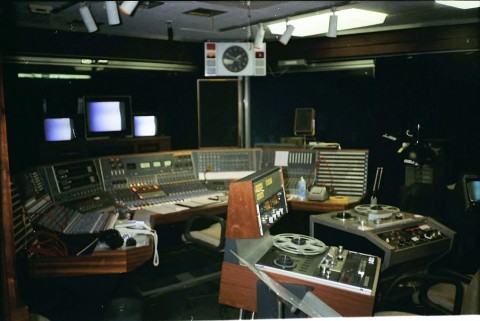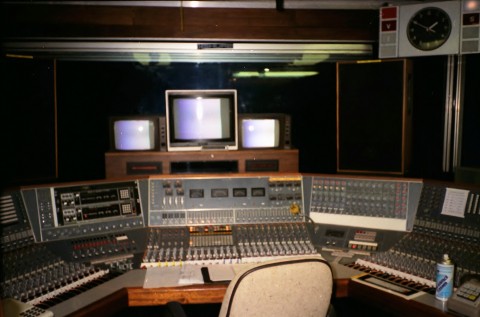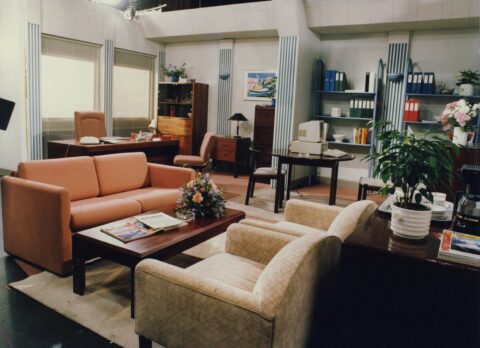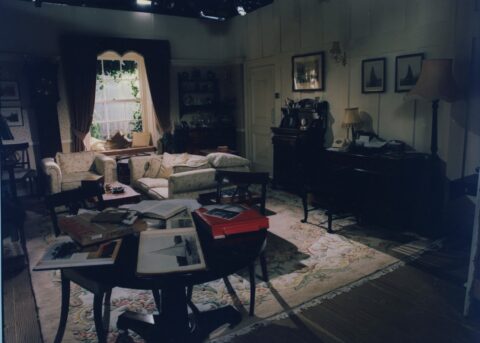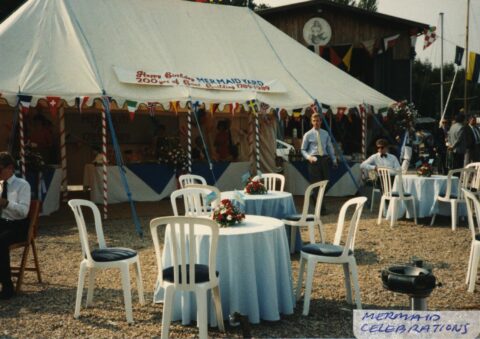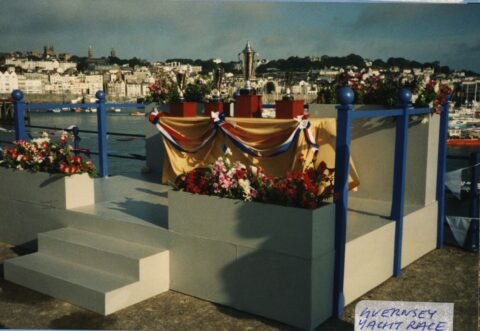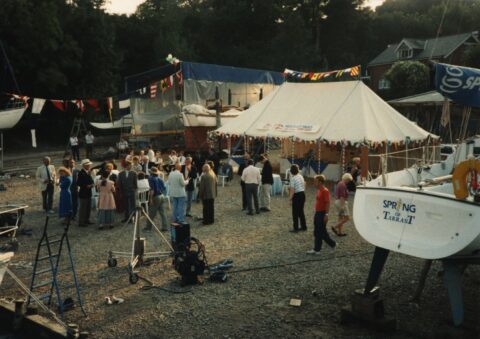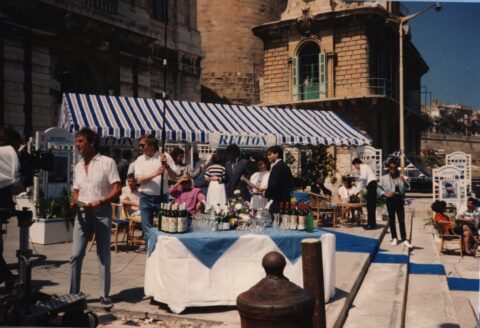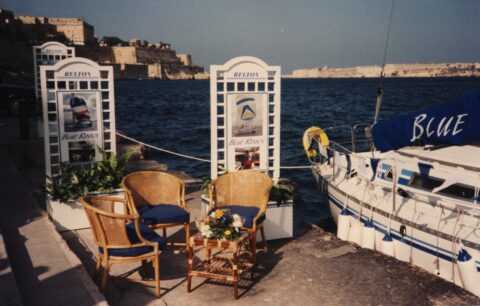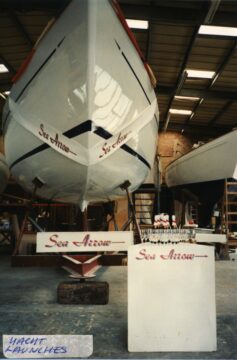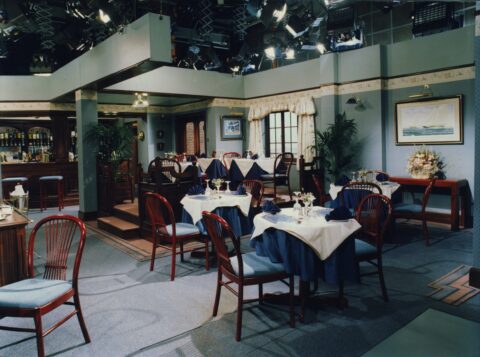Tag: Howards Way
Howard’s Way – Lynda Kettle’s photos
Photos by Lynda Kettle, no reproduction without permission. Lynda Kettle was a Production Designer at BBC Pebble Mill, working on factual, entertainment and drama shows in studio and on location. The photos were taken as records of the sets and locations.
Howard’s Way was produced by BBC London, but hosted out of Pebble Mill. It was recorded on location in Southampton, and the south coast, and in Studio A. The Sunday night drama series ran between 1985-1990, and was the BBC’s answer to Dynasty. The storyline follows Tom Howard who after being made redundant invests his time and money in a run down boat building yard. It starred Jan Harvey as Jan Howard, Stephen Yardley as Ken Masters, Glyn Owen as Jack Rolfe, Maurice Colbourne as Tom Howard and Kate O’Mara as Laura Wilde in later series. John William, Keith Salmon, Paul Woolston, Keith Froggatt, Dave Doogood, David Evans and Don Cooper all worked on the camera side. Lynda was production designer on 15 episodes in 1989-90.
These photos include several ‘before’ and ‘after’ shots of the initial locations (undressed), with the dressed version following on. The Southampton Civic Centre, re-dressed as Malta Airport is particularly impressive! The tank shots are really interesting. There are shots of the empty tank for the special effects storm, with shots of the full ‘storm’ and yacht in trouble!
Production Designer, Lynda Kettle also worked as a theatre designer and an artist, and now runs courses from her art studio http://www.lynda-kettle.com. She is a member of the Royal Birmingham Society of Artists, Birmingham Water Colour Society. Midland Pastel Society and Birmingham Art Circle . She exhibits her paintings several times a year at selected galleries.
More of a Way of Life than a Job – Les Podraza
By Les Podraza.
The first production I ever worked on was “Moonstone”. It was enormous, taking up the whole floor space of studio “A” at Pebble Mill. I was 19 and wet behind the ears! This brilliant place was to be my new home for over 25 years. Years that can only be described as unforgettable. Or to put it another way, in the words of Walt Disney “If it can be dreamed, it can be done.” I worked on so many productions I’ve lost count. I was so proud to work at Pebble Mill. As we all know, it became the Centre Of Excellence For Drama. And by golly did we churn some programmes out or what!
My parent department was Scenic Servicing, along with attachments to various other departments. I can hardly believe that it’s just a hole in the ground now! I loved being part of Pebble Mill and all it stood for, my job and all that went with it. Such a crying shame that all that talented and professional work force have moved on to pastures new, some of whom I see regularly still, and some have passed away. My thoughts go out to all their families.
To have worked for the BBC at Pebble Mill was distinctly a way of life and not a job as such. Every day was different that’s for sure. One day I would be building a set for Play For Today, the next day I’d be out on location somewhere in the UK. My friends and colleagues were my family. For some people that statement would be hard to understand, but when you spend so much of your time with people you work with, they do become your family. Hours spent working on shows, travelling, sleeping, and then working on shows. It wasn’t routine, and it could get very interesting at times. There were good and bad times but all in all it was a magical place to be involved with. I still possess many letters from producers and production crews alike thanking me for the good work me and my colleagues did on a particular show. These letters were so good for morale. That is probably why so many production crews wanted to work at Pebble Mill and not London. Because of the good will and professionalism they knew they would get from all the various departments that it took to produce brilliant programmes.
One particular event took place once a year. It was called Rum Punch day. All would meet up in the bar first and then move on down to the workshops. Nearly always on or between the 20th and the 23rd December. It was a chance to put up some glitzy sets in the studio workshops. I remember when Howard’s Way had finished. The main set was stored for Rum Punch. When staff from all departments and regions came down to the workshop floor, the place was rocking with a DJ at one end, with loads of overhead lighting on the dance floor, and the longest ever bar in the world at the other, with about 10 scene staff serving 200 to 300 people at once. We always got incredible comments every year. The worst one emotionally, was the last one ever in December 1992. I can remember seeing grown men crying, coming to terms with their redundancy notices for April 1993. It was a very sad time indeed.
There is so much I could say about the place that has made me so very proud to be a part of the best design and production facility in the world! But alas, there is not enough time or space here. But please enjoy my photographic memoirs of various productions I worked on. I’m sure you will find them very interesting. (Les’s photos are posted under the individual programme titles).
Keith Ackrill’s Memories of Working at Pebble Mill
KEITH ACKRILL – MEMORIES OF PEBBLE MILL
I worked at Pebble Mill on Radio 4 and television, from the day it opened until I left in 1982. I have very many pleasant recollections of the years I spent there.
The thing you noticed most was the tremendous enthusiasm that permeated the whole staff.
It was the feeling that we were in a brand new building hailed as the biggest combined radio and television complex in Europe. We were all determined to make Pebble Mill programming a force to be reckoned with.
Hours and hours of top television had the Pebble Mill label. As well as Birmingham productions, many London drama series were based in the studio or filmed on location, using Birmingham crews.
The Brothers, Poldark, All Creatures Great and Small, Juliet Bravo, Howards Way, even Basil Brush – the list goes on and on. And that doesn’t include the many classic dramas that were produced in Studio A.
Radio was an important part of the building’s output too. Radio Two programming found a home there, the Midlands Radio Orchestra was in residence for many years. Folk music, pop music – every kind of music came from Pebble Mill. And that’s not forgetting radio drama. Pebble Mill, of course, was home to The Archers and many other dramas of all kinds were produced alongside, together with some fine radio documentaries.
There were many landmark programmes – Top Gear, Pebble Mill At One, Saturday Night At The Mill – all of which I was fortunate to have worked on.
My main memories from the last programme include talking to actor Robert Wagner, in the hospitality room, about English beer. I know nothing about beer, but it was worth talking about it just have Natalie Wood’s dark brown eyes focused on me! I remember sitting across the table from Ginger Rogers and, later, photographing Bob Langley dancing with her – lucky devil – accompanied by Kenny Ball and his Jazzmen, with guest trumpeter James Hunt. Many, many great stars came to Pebble Mill to take part in the wide range of radio and television programmes that came from within that building.
I miss meeting them, but I also miss the camaraderie of the people I worked with, of being part of a team dedicated to putting broadcasting in the Midlands on the map.
